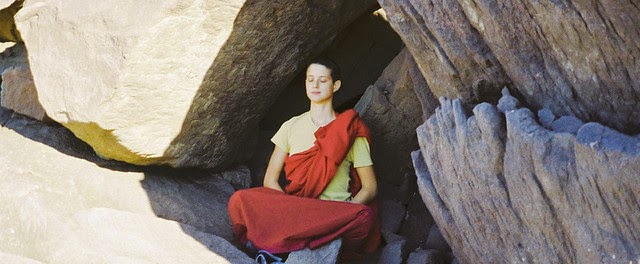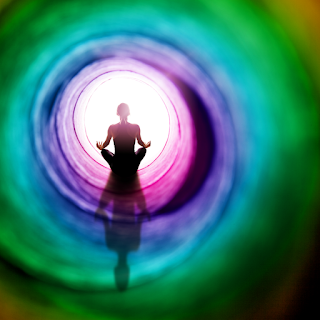The Yogic Lifestyle
The Yogic Lifestyle
 |
| You don't have to live a monastic lifestyle or meditate in a cave in this yogic path. |
Raising the Kundalini is not just about physical exercises; it involves a total lifestyle of consciousness. Because Kundalini Yoga is not a religion, it is not a requirement to do everything that the yogic lifestyle prescribes. It is acceptable to pick and choose what works for you; however, there are physical, mental, and spiritual benefits to everything, and I have found them all worth investigating. Many aspects of the yogic lifestyle should be familiar and complementary to a person living a faith-filled life and living the Lord’s law of health, or the Word of Wisdom, as Latter-day Saints call it. The Word of Wisdom was given through revelation to the prophet Joseph Smith “in consequence of evils and designs which do and will exist in the hearts of conspiring men in the last days” (Doctrine and Covenants 89:4).
A primary aspect of the yogic lifestyle is rising early to meditate. The Lord’s law also recommends early rising. Doctrine and Covenants 88:124 says, “Retire to thy bed early, that ye may not be weary; arise early, that your bodies and your minds may be invigorated.” The yogic technology of Ishnaan is very invigorating and is shared in the box on the following page.
Adherents to this yogic path are not required to live a monastic lifestyle. Kundalini Yoga is a technology suited for householders––people who have families and children and jobs and houses. Marriage is not only encouraged but considered the highest yoga. Every marriage is considered not only a union between two people but also between the couple and God.
In this yogic discipline, it is not necessary to give up wealth or possessions. In fact, material prosperity is important for developing society and having the resources to fulfill your destiny. Giving one-tenth to God (what most Christians call tithing) is encouraged not only in money but in all activities.
There are also yogi do’s and don’ts, known as yamas and niyamas. In an acorn shell, the Five Yogic Observances are purity, contentment, determination, study, and devotion/recognition of the One. The Five Yogic Abstinences, or things the yogi or yogini commits to adhere to, are non-violence, being truthful, not stealing, controlling the senses, and not being greedy.[1] The yogi lives a life filled with seva, or selfless service.
The Kundalini Yoga lifestyle is lacto-vegetarian, which means that meat and eggs are not eaten. With regard to consuming meat, the Lord counsels: “Yea, flesh also of beasts and of the fowls of the air, I, the Lord, have ordained for the use of man with thanksgiving; nevertheless they are to be used sparingly; and it is pleasing unto me that they should not be used, only in times of winter, or of cold, or famine” (Doctrine and Covenants 89:12–13).
When considering meat consumption from a health point of view, meat is one of the most acid-producing foods. Blood that is more acidic is ideal for cancer growth. Meat leaves toxins in our bodies because of the components of animal protein and the process required to break down these proteins. Meat it is among the greatest sources of cholesterol, and consuming meat can lead to hardening of the arteries and heart disease. Also important to consider is that most animals raised for consumption today are given chemicals and hormones to benefit in the production process, but these chemical and hormones can be harmful to consume. [2]
Other foods that yogis are recommended to avoid are white sugar, salt, nicotine, white bread, caffeine, and alcohol.
The Kundalini Yoga lifestyle also includes being drug free. Kundalini Yoga and drugs do not mix––even so-called natural drugs like marijuana, which Yogi Bhajan says is actually one of the worst drugs because it smokes the gray matter in your brain.[3] Yogi Bhajan says the following: “Drugs are not being taken for any other reason than that people cannot face their reality, yet drugs take them to non-reality. At that moment give them survival, that’s all. Every stimulant, every drug, every love, every relationship is based on affirmation of non-reality.” [4]
The Lord’s law of health likewise eschews drugs and other harmful substances. According to Elder M. Russell Ballard: “The battle over man’s God-given agency continues today. Satan . . . uses addiction to steal away agency. . . . Researchers tell us there is a mechanism in our brain called the pleasure center. When activated by certain drugs or behaviors, it overpowers the part of our brain that governs our willpower, judgment, logic, and morality. This leads the addict to abandon what he or she knows is right.”[5]
The blessings and promises that come from living the Lord’s law of health are astounding: “And all saints who remember to keep and do these sayings, walking in obedience to the commandments, shall receive health in their navel and marrow to their bones; And shall find wisdom and great treasures of knowledge, even hidden treasures; And shall run and not be weary, and shall walk and not faint. And I, the Lord, give unto them a promise, that the destroying angel shall pass by them, as the children of Israel, and not slay them” (Doctrine and Covenants 89:18–21).
Ishnaan: The Science of Hydrotherapy, or the Yogi Cold Shower
The ancient yogis knew the benefits of a cold shower in the ambrosial hours, before meditating. And they had to work hard to get it, carrying buckets of water to the top of a ladder. We are fortunate to have running water and removable shower heads. But there is more to this practice than just cold water; it is an ancient and sacred science. What else did you expect?
This science is called ishnaan––when the body, by its own virtue, creates the temperature that can beat off the coldness of the water. Ishnaan is not just wetting your body. There is a grace to it.
I recommend beginning by massaging the body with organic, cold-pressed almond oil or sesame oil. Use a dry brush to bring the blood to the surface of the skin until the skin is hot.
Then, put your extremities under the cold water. Start with the feet. Then the hands and arms. Use one foot to massage the other while under the cold water. Let the water hit different parts of your body; you will experience different energetic effects. Then stand away from the stream for a while, and use both hands to massage your body until your body gets hot.
Then get under the cold stream of water again, and massage your body again. Continue this process for about ten to fifteen minutes or until you feel warm. Chanting a mantra makes it much easier! When you come out, your entire caliber will be different. You will have a radiant glow, and all of your organs will be rebuilt.
The body’s automatic response to the cold water will be to bring blood flow to the central organs, which will flush the organs and the capillaries. Flushing the organs changes the secretions of the glands, leading to youth in not only the physical appearance of the body but also the way the body runs and regulates.[6]
Precautions
There are a few important cautions. Be sure to start with your feet and hands. The thighs, genitals, and head should never be first. Avoid cold showers during pregnancy and menstruation. Cold showers should also be avoided if you have a fever, rheumatism, or heart disease. If you have high blood pressure or sciatic nerve problems, start slowly. [7]
[1] Yogi Bhajan, The Aquarian Teacher: KRI International Kundalini Yoga Teacher Training Level 1 Yoga Manual (Santa Cruz, NM: Kundalini Research Institute, 2007), 44.
[2] Bhajan, The Aquarian Teacher, 250.
[3] Ibid.
[4] Ibid.
[5] M. Russell Ballard, “O That Cunning Plan of the Evil One,” Ensign, November 2010, http://www.lds.org/general-conference/2010/10/o-that-cunning-plan-of-the-evil-one.
[6] Kundalini Research Institute, KRI International Teacher Training Manual, Level 1, 4th ed. (Santa Cruz, NM: Kundalini Research Institute, 2007), 248.
[7] Ibid.





Comments
Post a Comment